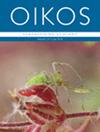Variation in the strength of local and regional determinants of herbivory across the Neotropics
IF 3
2区 环境科学与生态学
Q2 ECOLOGY
引用次数: 0
Abstract
Insect herbivory can be an important selective pressure and contribute substantially to local plant richness. As herbivory is the result of numerous ecological and evolutionary processes, such as complex insect population dynamics and evolution of plant antiherbivore defenses, it has been difficult to predict variation in herbivory across meaningful spatial scales. In the present work, we characterize patterns of herbivory on plants in a species‐rich and abundant tropical genus (Piper) across forests spanning 44° of latitude in the Neotropics. We modeled the effects of geography, climate, resource availability, and Piper species richness on the median, dispersion, and skew of generalist and specialist herbivory. By examining these multiple components of the distribution of herbivory, we were able to determine factors that increase biologically meaningful herbivory at the upper ends of the distribution (indicated by skew and dispersion). We observed a roughly twofold increase in median herbivory in humid relative to seasonal forests, which aligns with the hypothesis that precipitation seasonality plays a critical role in shaping interaction diversity within tropical ecosystems. Site level variables such as latitude, seasonality, and maximum Piper richness explained the positive skew in herbivory at the local scale (plot level) better for assemblages of Piper congeners than for a single species. Predictors that varied between local communities, such as resource availability and diversity, best explained the distribution of herbivory within sites, dampening broad patterns across latitude and climate and demonstrating why generalizations about gradients in herbivory have been elusive. The estimated population means, dispersion, and skew of herbivory responded differently to abiotic and biotic factors, illustrating the need for careful studies to explore distributions of herbivory and their effects on forest diversity.新热带地区食草动物的地方和区域决定因素的强度差异
昆虫的食草行为可能是一种重要的选择性压力,对当地植物的丰富性有很大影响。由于草食性是众多生态和进化过程的结果,如复杂的昆虫种群动态和植物抗草食性防御系统的进化,因此很难预测草食性在有意义的空间尺度上的变化。在本研究中,我们描述了新热带地区纬度为 44°的森林中物种丰富的热带属(胡椒属)植物的食草模式。我们模拟了地理、气候、资源可用性和瓜蒌属物种丰富度对通性和专性草食性的中位数、分散性和偏斜性的影响。通过研究食草动物分布的多个组成部分,我们能够确定在分布的上端(以偏斜和离散度表示)增加有生物意义的食草动物的因素。我们观察到,相对于季节性森林,潮湿森林的食草量中位数大约增加了两倍,这与降水季节性在热带生态系统中形成相互作用多样性方面起着关键作用的假设相吻合。纬度、季节性和吹笛翁最大富集度等地点水平变量对吹笛翁同系物组合的局部尺度(地块水平)草食性正偏斜的解释比对单一物种的解释更好。不同地方群落之间的预测因子,如资源可用性和多样性,最能解释草食性在地点内的分布,抑制了不同纬度和气候之间的广泛模式,并证明了为什么草食性梯度的概括一直难以实现。估计的食草动物种群平均值、分散度和偏斜度对非生物因素和生物因素的反应不同,这说明有必要进行仔细研究,探索食草动物的分布及其对森林多样性的影响。
本文章由计算机程序翻译,如有差异,请以英文原文为准。
求助全文
约1分钟内获得全文
求助全文
来源期刊

Oikos
环境科学-生态学
CiteScore
6.20
自引率
5.90%
发文量
152
审稿时长
6-12 weeks
期刊介绍:
Oikos publishes original and innovative research on all aspects of ecology, defined as organism-environment interactions at various spatiotemporal scales, so including macroecology and evolutionary ecology. Emphasis is on theoretical and empirical work aimed at generalization and synthesis across taxa, systems and ecological disciplines. Papers can contribute to new developments in ecology by reporting novel theory or critical empirical results, and "synthesis" can include developing new theory, tests of general hypotheses, or bringing together established or emerging areas of ecology. Confirming or extending the established literature, by for example showing results that are novel for a new taxon, or purely applied research, is given low priority.
 求助内容:
求助内容: 应助结果提醒方式:
应助结果提醒方式:


